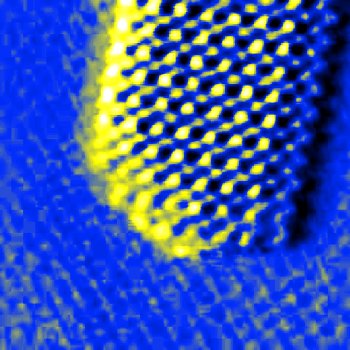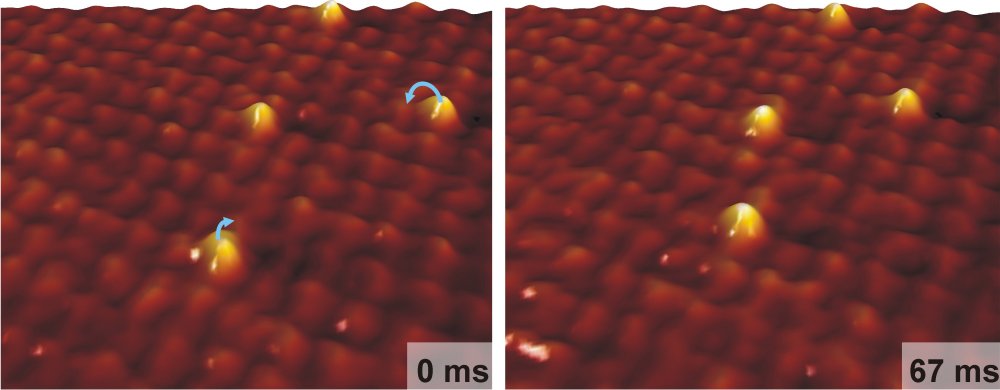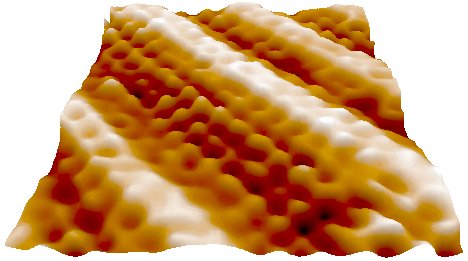Video - STM
|
Interfaces between solid metals and liquid electrolyte solutions play a central role in electrochemical processes,
ranging from corrosion to galvanic deposition and electrode reactions in batteries and fuel cells.
The motion and interaction of atomic and molecular species at these interfaces is an important fundamental
step in many of those reactions and of considerable relevance for understanding their precise mechanisms.
Our group has developed a worldwide unique high-speed scanning tunnelling microscope (Video-STM),
capable of directly observing these dynamic processes with atomic resolution and millisecond time resolution
in electrochemical environment.
Examples can be downloaded from our
Atomic Movie Library.
By performing these microscopic investigations at variable electrode
potential and temperature and analyzing them with statistical methods we can measure the involved energies
and obtain detailed data on the dynamics of these elemental processes in well-suited model systems.
The following topics have been studied by this technique:
|
|
Dissolution and electrodeposition processes, focussing on the dynamics of kinks in atomic steps on the metal surface.
Understanding these processes is of key importance for modern galvanic plating and etching methods.
Examples of studied systems are copper dissolution and deposition, lead-copper alloy formation, and the
growth of nanoscale needles in Bismuth deposition.
|

|
|
Surface dynamics of adsorbates at solid-liquid interfaces, such as quantitative studies of adsorbate
surface diffusion and adsorbate-adsorbate interactions. Our experiments, performed primarily for sulphur
on a copper surface in hydrochloric acid solution, constitute the first direct experimental measurements
of the relevant energies of these processes for adsorbates at solid-liquid interfaces.
|

|
|
Collective nanoscale surface dynamics, specifically the dynamic behavior of surface reconstructions
on gold and copper electrode surfaces. These reconstructions form beautiful nanoscale patterns on the
metal surfaces, resulting from a rearrangement of the atoms in the metal surface layer, and have a
pronounced influence on growth processes and interface reactions. Our studies show that these structures
are surprisingly mobile and reveal complex mechanisms of the reconstruction formation and dissolution.
|

|
Contact: Prof. Olaf Magnussen
Funding: DFG projects MA 1618/5, MA 1618/11, MA 1618/14, MA 1618/15
Selected publications:
- Thiolate-induced surface reconstruction of Cu(100) electrodes studied by in situ Video-STM
Y.-C. Yang, O.M. Magnussen, J. Electroanal. Chem., 716, 80-86 (2014)
- In situ Video-scanning tunneling microscopy studies of the structure and dynamics of Cl adlayers on Au(100) electrodes
Y.-C. Yang, K. Hecker, O.M. Magnussen, Electrochim. Acta, 112, 881-886 (2013)
- Quantitative studies of adsorbate dynamics at noble metal electrodes by in situ Video-STM
Y.-C. Yang, O.M. Magnussen, Phys. Chem. Chem. Phys., 15, 12480-12487 (2013)
- In situ Video-STM studies of methyl thiolate surface dynamics and self-assembly on Cu(100) electrodes
Y.-C. Yang, A. Taranovskyy, O.M. Magnussen, Langmuir, 48, 14143-14154 (2012)
- Studies of electrochemical surface alloying and dealloying by in situ high-speed STM
A. Taranovskyy, S. Guézo, H. Matsushima, Y. Gründer, O.M. Magnussen, Phys. Chem. Chem. Phys., 14, 10579-10588 (2012)
- Thiolat-induzierter Einfang von Metalladatomen an Fest-flüssig-Grenzflächen
Y.-C. Yang, A. Taranovskyy, O.M. Magnussen, Angew. Chem., 124, 2003-2007 (2012)
- Thiolate-induced metal adatom trapping at solid-liquid interfaces
Y.-C. Yang, A. Taranovskyy, O.M. Magnussen, Angew. Chem. Int. Ed. 51, 1966-1969 (2012);
- Surface dynamics of lead adsorbates at the Cu(100) - electrolyte interface
S. Guézo, A. Taranovskyy, H. Matsushima, O.M. Magnussen, J. Phys. Chem. C., 115, 19336 (2011)
- In-Situ Video STM Studies of the hydrogen-induced Reconstruction of Cu(100):Potential and pH Dependence
H. Matsushima, C. Haak, A. Taranovskyy, Y. Gründer, O. M. Magnussen, Phys. Chem. Chem. Phys., 12, 13992-13998 (2010)
- In situ Video-STM studies of sulfate dynamics on Au(111)
K. Suto, O. M. Magnussen, J. Electroanal. Chem., 649, 136-141 (2010)
- In Situ Video-STM studies of adsorbate dynamics at electrochemical interfaces
T. Tansel, A. Taranovskyy, O.M. Magnussen, Chem.Phys.Chem., 11, 1438-1445 (2010)
- Quantitative Measurements of adsorbate-adsorbate interactions at solid-liquid interfaces
A. Taranovskyy, T. Tansel, O.M. Magnussen, Phys. Rev. Lett., 104, 106101 (2010)
- Quantitative Measurements of adsorbate-adsorbate interactions at solid-liquid interfaces
A. Taranovskyy, T. Tansel, O.M. Magnussen, submitted (2010).
- In situ Video-STM studies of sulfate dynamics on Au(111)
K. Suto, O. M. Magnussen, J. Electroanal. Chem., in press (2010).
- Studies of Adsorbate Dynamics by In Situ Video-STM: Surface Diffusion, Adsorbate-Adsorbate Interactions, and Interactions with Defects
T. Tansel, A. Taranovskyy, O.M. Magnussen, Chem.Phys.Chem., in press (2010).
- Reconstruction of Cu(100) electrode surfaces during hydrogen evolution
H. Matsushima, A. Taranovskyy, C. Haak, Y. Gründer and O.M. Magnussen, J. Am. Chem. Soc. 131, 10362–10363 (2009).
- Video-STM studies of adsorbate diffusion at electrochemical interfaces
T. Tansel, O.M. Magnussen, Phys. Rev. Lett., 96, 026101 (2006).
- Surface dynamics of nanoscale “hex” strings on Au(100) electrodes
M. Labayen, C. Haak, O.M. Magnussen, Phys. Rev. B, rapid Comm., 71, 241409(R) (2005).
- In situ Video-STM study of the potential-induced (1x1) ? “hex” transition on Au(100) electrode surfaces in Cl containing solution
M. Labayen, O.M. Magnussen, Surf. Sci., 573, 128-139 (2004).
- Quasi-collective motion of nanoscale metal strings in metal surfaces
M. Labayen, C. Ramirez, W. Schattke, O.M. Magnussen, Nature Materials, 2, 783-787 (2003).
- In situ Video-STM studies of Cu electrodeposition on Cu(100) in HCl solution
W. Polewska, R.J. Behm, O.M. Magnussen, Electrochim. Acta, 48, 2915-2921 (2003).
- In situ Video-STM studies of dynamic processes at electrochemical interfaces
O.M. Magnussen, W. Polewska, L. Zitzler, R.J. Behm, Faraday Discuss., 121, 43-52 (2002).
- In-situ atomic-scale studies of the mechanisms and dynamics of metal dissolution by high-speed STM
O.M. Magnussen, L. Zitzler, B. Gleich, M.R.Vogt, R.J. Behm, Electrochim. Acta, 46, 3725-3733 (2001).
- Electrochemical Video-STM
L. Zitzler, B. Gleich, O.M. Magnussen, R.J. Behm, in: Localized In Situ Methods for Investigating Electrochemical Interfaces, Eds. A.C. Hillier, M. Seo, S.R. Taylor, Proc. Electrochem. Soc., 99-28, 29-38 (2000).


